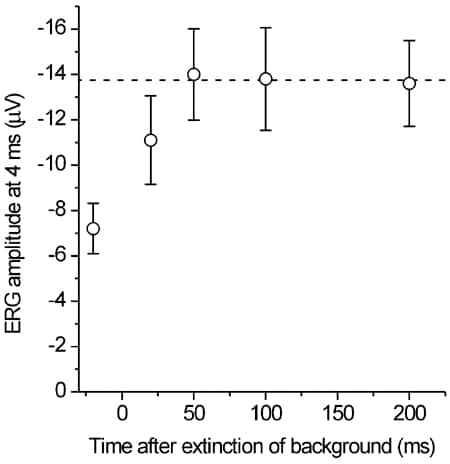It has been shown that, following a 30 s exposure to intense illumination that bleached around half the photopigment, the cone photoreceptor circulating current recovered to its dark-adapted level within several seconds (Paupoo et al. 2000). We now investigate recovery on a faster time scale, following longer, more intense exposures. We recorded the corneal ERG from human subjects using a conductive fibre electrode.
Approval was obtained from the local Research Ethics Committee, and subjects gave informed written consent. We delivered all stimuli in a ganzfeld apparatus after dilating the subject’s pupil (Paupoo et al. 2000). The eye was exposed to white light of ~37 000 photopic Td from 12 LEDs (Luxeon LXHL-BW01) until a steady-state bleach was achieved (estimated as ~85 % pigment bleached). The LEDs were then extinguished for a short period, and a bright flash was delivered. The flash intensity (~9800 Td s) and the duration in darkness (250 ms) were chosen so that the total light flux barely changed. Cycles of LED extinction and flash delivery were repeated at 4 s intervals.
Figure 1 plots the response amplitude, for flashes presented at a range of times relative to extinction of the background. For comparison, the dashed line shows the amplitude obtained under dark-adapted conditions, with an equivalent flash (i.e. delivering the same number of photoisomerizations). For flashes presented during the background (-20 ms), the amplitude was around half the dark-adapted level, but following extinction of the LEDs, the amplitude recovered within 50 ms. In rod photoreceptors, the circulating current is completely suppressed during, and for ~5 min after, illumination that produces a bleach of this level (Thomas & Lamb, 1999).
Our results indicate that, in contrast, cones are able to preserve around half their circulating current during steady-state exposure to a large bleach (~85 %), and that, at extinction of the light, they are able to recover their full circulating current within 50 ms, several thousand times faster than rods.

